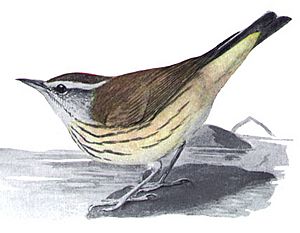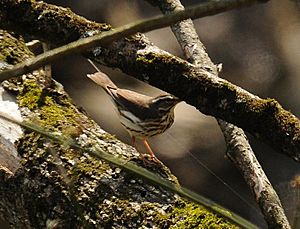Louisiana waterthrush facts for kids
Quick facts for kids Louisiana waterthrush |
|
|---|---|
 |
|
| illustration by Louis Agassiz Fuertes | |
| Conservation status | |
| Scientific classification | |
| Genus: |
Parkesia
|
| Species: |
motacilla
|
 |
|
| Range of P. motacilla Breeding range
Wintering range |
|
| Synonyms | |
|
Seiurus motacilla |
|
The Louisiana waterthrush (Parkesia motacilla) is a small, brown bird that looks a bit like a New World warbler. It lives in eastern North America and flies south to the West Indies and Central America for the winter. This bird is plain brown on its back and white underneath, with black stripes on its chest. It also has a special buff (light brownish-yellow) color on its sides and under its tail. This helps tell it apart from its close cousin, the northern waterthrush. You'll often find Louisiana waterthrushes near streams and other wet places.
Contents
Where They Live and Travel
The Louisiana waterthrush spends its summers in eastern North America. You can find it from southern Canada all the way down through the eastern United States. It doesn't usually live in Florida or along the coast during this time.
This bird is a migratory traveler. When winter comes, it flies south to warmer places like Central America and the West Indies. It's very rare to see one in the western United States.
These birds are some of the first "neotropical migrants" to return north in the spring. They often finish their long journey in late March or early April. That's almost two months before most other warblers arrive! They are also one of the first warblers to leave their summer homes. Some start heading south as early as July, and almost all are gone by late August.
What They Look Like
The Louisiana waterthrush has a plain brown back and white belly with black streaks. Its sides and the area under its tail are a buff color. It has a clear, white stripe above its eye that flares out. Its legs are a bright pink.
Young birds look similar, but their undersides are buff instead of white. It's easy to confuse this bird with its close relative, the northern waterthrush (Parkesia noveboracensis). The northern waterthrush has white sides and undertail, a striped throat, and duller pink legs. Its bill is also a bit smaller, and the stripe above its eye is shorter.
The Louisiana waterthrush is the largest type of wood warbler. It measures about 14 to 17 centimeters (5.5 to 6.7 inches) long. Its wings can spread out from 21 to 25.4 centimeters (8.3 to 10 inches) wide. An adult bird usually weighs between 17.4 and 28 grams (0.6 to 1 ounce).
Their Song and Call
The male Louisiana waterthrush sings a beautiful, unique song. It's a series of musical notes that go down in pitch, followed by a warbling sound. Imagine the sound of a stream flowing downhill – that's often how their song sounds! The northern waterthrush's song doesn't change pitch as much. The Louisiana waterthrush's call is a sharp chink sound.
Just like the northern waterthrush, the Louisiana waterthrush often bobs its tail up and down.
Life and Habits
Male Louisiana waterthrushes don't sing much in their winter homes. But as soon as they arrive back in their breeding territory, they start singing right away! When a male is trying to claim his territory, he sings loudly almost all day. After he finds a mate, he sings less often, mostly in the mornings.
Where They Nest
These birds like to breed in wet woodlands near flowing water. They don't usually nest anywhere else. However, in winter, they often look for food along flooded roads, trails, parks, and even gardens. They rarely go into deep forests during winter. The northern waterthrush, on the other hand, prefers swampy, still waters.
Louisiana waterthrushes build their nests in dense plants along the water's edge. This helps protect their nests from animals that might try to eat their eggs or young. They build a cup-shaped nest in a rock crack, a mud bank, or among tree roots. They lay 4 to 6 eggs from late May to mid-June.
Both parents help build the nest. They use wet, muddy leaves, pine needles, grass, and small twigs. The female bird sits on the eggs for 12 or 13 days to keep them warm. After the chicks hatch, they stay in the nest for 9 or 10 days. Both parents feed the young birds for about 4 more weeks after they leave the nest.
What They Eat
The Louisiana waterthrush is one of the few songbirds that mostly finds its food in moving water. They mainly eat insects that live in the water, as well as molluscs (like snails) and crustaceans (like tiny crabs). Sometimes, they also eat insects found on the ground, such as beetles and ants. They might even catch flying insects, like flies, right out of the air. They also look for food among fallen leaves. If there aren't many insects, they can even catch larger prey like salamanders and small fish.
Challenges and Conservation
The Louisiana waterthrush is not as common today as it was about 200 years ago. This is mainly because their homes are disappearing. People have cleared and changed streams, caused pollution, and built dams that create reservoirs. All these things reduce the places where these birds can live.
Also, the Louisiana waterthrush needs large areas of continuous forest. When forests are broken up into smaller pieces, it threatens this species. Logging, farming, city growth, and gas drilling can further reduce their habitat. The number of these birds seems to be very sensitive to how good their habitat is and how much of it there is.
In Canada, some threats to this bird include fewer insects to eat and less water because of farm drainage, too much irrigation, and climate change. Logging and habitat breaking up also cause problems for them.
See also
 In Spanish: Chipe de Agua Sureño para niños
In Spanish: Chipe de Agua Sureño para niños



